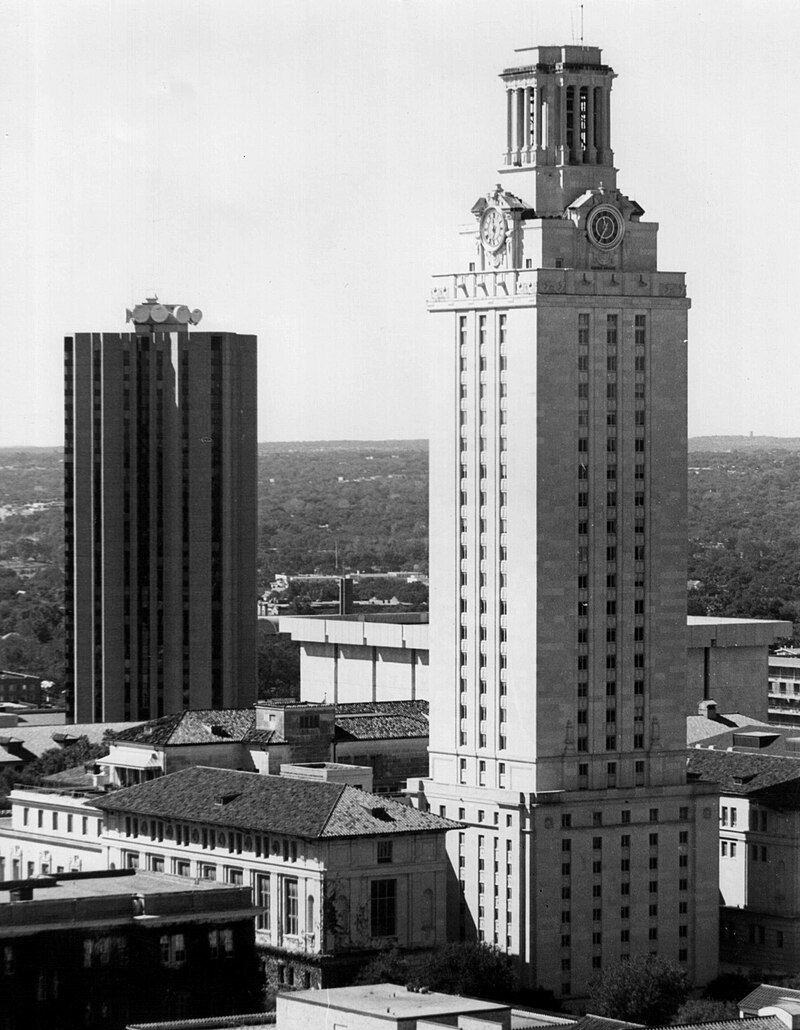Fifty years have passed since Charles Whitman went on an infamous killing spree at the University of Texas. Now a group of historians at UT have taken an in depth look at Whitman and his actions, and tried to answer questions we still don’t fully understand today.
By Larry D. Moore, CC BY-SA 3.0, Wikimedia Commons
What happens to events that historians ignore, events that are recorded primarily as scattered patches of memory? What kind of history is told by novelists and journalists?
We all know what happened, right?
On August 1, 1966, a twenty-five year old University of Texas student named Charles Whitman went up to the observation deck of the UT tower armed with guns, ammunition, and canned food. For 96 minutes he held the campus in a state of terror. Whitman killed 14 people that day and wounded more than 30. One of the wounded died a week later and one died decades later of injuries connected with his bullet wounds. Austin Police officers Houston McCoy and Ramiro Martinez (and two other men) made their way to the top of the tower, without knowing who or what they would find. They cornered Whitman and then shot and killed him. Later it was discovered that Whitman had murdered his mother and his wife in the early hours of the morning before his rampage. The shooting was broadcast on the radio and on television and it became a major national and even international news story.
This is arguably the most important event to take place in modern Austin history. There were thousands of eyewitnesses and dozens of survivors. The local archives contain police reports, records of a high-profile Governor’s Commission, medical records, military records, and university records. We have dozens of interviews with survivors: with people who remember and people who have been trying to forget.
It took 30 years for a journalist, Gary Lavergne, to write A Sniper in the Tower, a well-researched and thoughtful narrative. A few oral histories appeared over the years in Texas Monthly and local newspapers. It was only in 2006, that Texas Monthly Senior Editor Pam Colloff spent three months tracking down survivors and recording their memories. In 2014, Elizabeth Crook published a novel about that day called Monday, Monday. Movies, TV shows, novels and even songs refer to the shooting in passing.
But where are the historians?
Bullet holes remained in the concrete and balustrades around the tower when I arrived at UT as an Assistant Professor in 1990, but no visible commemorative marker of the events of that day existed on the UT campus. In 1999 the garden behind the tower was dedicated to the memory of those killed, wounded, or touched by the shooting, but then it took another 8 years to add a plaque that publicly acknowledged that commemoration for the first time. The History tab on the UT webpage devoted to the tower still doesn’t even mention the shooting.
These are events that cry out to be studied. They are also events that raise important questions about commemoration, about public remembering and forgetting, and about the uses of public history.
In Spring 2016, graduate students in the UT History Department’s Public History Seminar set out to construct a website for writing a history of … and immediately we ran into our first problem. What are we studying? The events of August 1, 1966? Charles Whitman himself? The victims and survivors? The immediate responses, or the aftermath, or the public memories? Do people have a right to forget? What do we want to know? What questions do we have and what questions to we want to answer?
Link via Slate. There’s a lot there to read, and a lot we’re still learning even after all these years. I for one did not know that Whitman had a serious addiction to amphetamines, which no one made a big deal about because amphetamines were so common at the time. Check it out.

